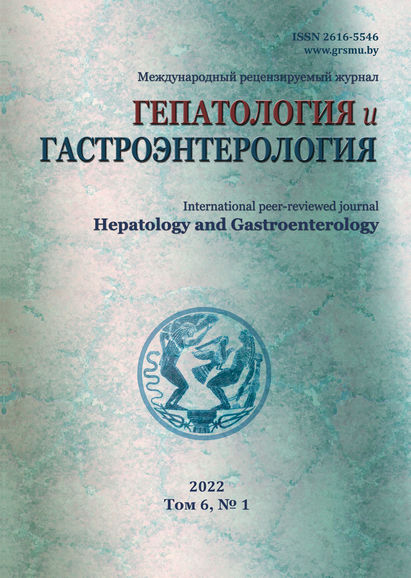ЭПИДЕМИОЛОГИЧЕСКАЯ ХАРАКТЕРИСТИКА ГЕПАТИТА Е В РЕСПУБЛИКЕ БЕЛАРУСЬ
Аннотация
Введение. Показатели заболеваемости гепатитом Е (ВГЕ) в Беларуси не соответствуют частоте встречаемости анамнестических антител у жителей республики.
Цель исследования – изучение эпидемического процесса ВГЕ в Беларуси.
Материал и методы. Изучено 5745 сывороток крови на наличие анти-ВГЕ IgG и IgM: у жителей Брест-ской и Минской областей (n=2784), иностранных граждан (n=1457), у доноров крови (n=378), у домашних свиней (n=1126). Исследовано 130 сывороток крови на наличие РНК ВГЕ. Секвенировано 9 фрагментов генома ВГЕ. Проведено генотипирование 37 последовательностей ВГЕ.
Результаты. Серопревалентность анти-ВГЕ IgG в общей популяции жителей Беларуси составляет 7,3% (95 ДИ 5,8-9,0), в группе пациентов с поражением печени – 11,2% (95% ДИ 9,6-12,9), у иностранных граждан – 5,22% (95% ДИ 4,11-6,53), у домашних свиней – 33,75% (95% ДИ 30,44-37,32). Встречаемость анти-ВГЕ IgM у людей общей популяции составляет 1,35% (95% ДИ 0,75-2,22), у АлАт положительных пациентов – 4,25% (95% ДИ 3,32-5,37), у иностранных граждан – 1,03% (95% ДИ 0,58-1,7), у АлАт положительных доноров – 2,89% (95% ДИ 1,25-5,69). Все последовательности РНК ВГЕ, выделенные в Беларуси, вызваны 3 генотипом.
Выводы. Дана эпидемиологическая характеристика ВГЕ в Беларуси. Изучена иммуноструктура анти-ВГЕ разных когорт населения. Установлены случаи завоза ВГЕ на территорию республики, выявлены аутохтонные случаи ГЕ.
Литература
Echevarría JM. Light and Darkness: Prevalence of Hepatitis E Virus Infection among the General Population. Scientifica (Cairo). 2014;2014:481016. https://doi.org/10.1155/2014/481016
Balayan MS, Andjaparidze AG, Savinskaya SS, Ketiladze ES, Braginsky DM, Savinov AP, Poleschuk VF. Evidence for a Virus in Non-A, Non-B Hepatitis Transmitted via the Fecal-Oral Route. Intervirology. 1983;20(1):23-31. https://doi.org/10.1159/000149370
Krawczynski K, Meng XJ, Rybczynska J. Pathogenetic elements of hepatitis E and animal models of HEV infection. Virus Research. 2011;161(1):78-83. https://doi.org/10.1016/j.virusres.2011.03.007
Fogeda M, Avellón A, Cilla CG, Echevarría JM. Imported and autochthonous hepatitis E virus strains in Spain. Journal of Medical Virology. 2009;81(10):1743-1749. https://doi.org/10.1002/jmv.21564
Rein DB, Stevens GA, Theaker J, Wittenborn JS, Wiersma ST. The global burden of hepatitis E virus genotypes 1 and 2 in 2005. Hepatology. 2012;55(4):988-997. https://doi.org/10.1002/hep.25505
Feagins AR, Opriessnig T, Guenette DK, Halbur PG, Meng XJ. Detection and characterization of infectious Hepatitis E virus from commercial pig livers sold in local grocery stores in the USA. Journal of General Virology. 2007;88(3):912-917. https://doi.org/10.1099/vir.0.82613-0
Pelosi E, Clarke I. Hepatitis E: a complex and global disease. Emerg Health Threats J. 2008;1:e8. https://doi.org/10.3134/ehtj.08.008
Meng XJ. Hepatitis E virus: Animal reservoirs and zoonotic risk. Vet Microbiol. 2010;140(3-4):256-265. https://doi.org/10.1016/j.vetmic.2009.03.017
Pavio N, Meng XJ, Renou C. Zoonotic hepatitis E: animal reservoirs and emerging risks. Vet. Res. 2010;41(6):46. https://doi.org/10.1051/vetres/2010018
Faber MS, Thamm M, Höhle M, Stark K. Hepatitis E Virus Seroprevalence among Adults, Germany. Emerging Infectious Diseases. 2012;18(10):1654-1657. https://doi.org/10.3201/eid1810.111756
Zhavoronok SV, Karpov IA, Mihajlov MI, Arabej AA, Kashkur JuV, Kjuregjan KK, Karlsen AA, Malinnikova EJu, Marchuk SI, Znovec TV, Davydov VV, Alatorceva GI, Gasich EL, Jagovdik-Telezhnaja EN, Gutmane VR, Shumskij JuI, Anis'ko LA, Rogacheva TA, Docenko ML, Krasochko PA, Borisovec DS. Intensivnost' jepidemicheskogo i jepizooticheskogo processov infekcii, vyzvannoj virusom gepatita E, na territorii Respubliki Belarus [Intensity of epidemic and epizootic processes of infectioncaused by hepatitis E virus on the territory of the Republic of Belarus]. Infekcionnye bolezni: novosti, mnenija, obuchenie [Infectious diseases: news, opinions, training]. 2019;8(1):11-22. (Russian). https://doi.org/10.24411/2305-3496-2019-11001.
Boyle MDP, editor. Bacterial Immunoglobulin - Binding Proteins. Vol. 2, Applications in Immunotechnology. New York: Acad. Press; 1990. 494 p. https://doi.org/10.1016/B978-0-12-123012-8.50005-3
Arabej AA, Marchuk SI, Zhavoronok SV, Davydov VV, Kjuregjan KK, Mihajlov MI. Adaptirovannyj metod polimeraznoj cepnoj reakcii dlja vyjavlenija gepatita E u cheloveka i zhivotnyh [Adapted polymerase chain reaction method for detecting hepatitis E virus in humans and animals]. Voennaja medicina [Military Medicine]. 2018;3:86-92. (Russian).
Kumar S, Stecher G, Li M, Knyaz C, Tamura K. MEGA X: Molecular Evolutionary Genetics Analysis across computing platforms. Molecular Biology and Evolution. 2018;35(6):1547-1549. https://doi.org/10.1093/molbev/msy096


















2.png)






